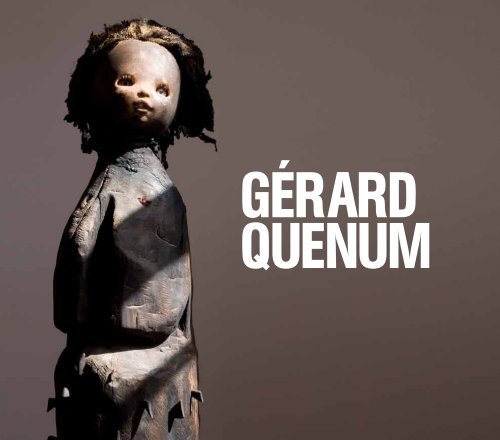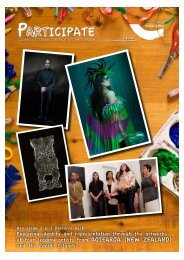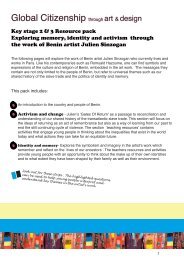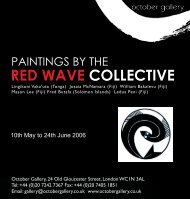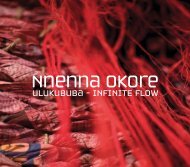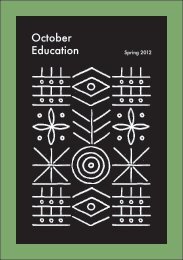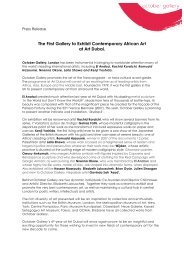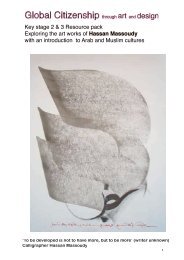View a preview of this book (PDF) - October Gallery
View a preview of this book (PDF) - October Gallery
View a preview of this book (PDF) - October Gallery
Create successful ePaper yourself
Turn your PDF publications into a flip-book with our unique Google optimized e-Paper software.
cover:<br />
Mère du Secret (Mother <strong>of</strong> Secrets), 2008.<br />
Wood, doll, plastic and metal, 200 x 30cm.<br />
opposite:<br />
Japonaise (Japanese Woman), 2009.<br />
Mixed media, height 231cm.
GÉRARD<br />
On a November evening in<br />
1998 whilst relaxing alongside<br />
friends eating their “poulets<br />
bicyclettes” in the Maquis<br />
Dunya restaurant in Cotonou, I<br />
QUENUM<br />
was unable to take my eyes <strong>of</strong>f<br />
a badly-lit picture hung far too<br />
high up on the opposite wall. I<br />
say picture; more like a collage!<br />
Where, sticking out <strong>of</strong> an ochre<br />
background were the head <strong>of</strong> a<br />
doll, several small bones and a<br />
statuette. Three or four similar<br />
<strong>of</strong>ferings could be discerned<br />
strung up, in semi-obscurity, on other walls <strong>of</strong> the dimly-lit room. On leaving, I noticed,<br />
on a small label, a name and the presumed title: “Gérard Quenum: Interior Voices.”<br />
Still today, more than ten years on, my fascination with the work <strong>of</strong> Gérard Quenum<br />
remains intact, and indeed is renewed each time I pass before the gate <strong>of</strong> his patio<br />
cum atelier facing onto the lagoon <strong>of</strong> Porto Novo. But how do I explain to myself <strong>this</strong><br />
fascination? It is, perhaps, that Gérard’s sculptures leave me standing at a crossroads <strong>of</strong><br />
disconnected questions, interrupted thoughts, all vying for expression, fighting to be heard.<br />
There are, <strong>of</strong> course, Gérard’s dolls. They speak to me directly <strong>of</strong> his pain, <strong>of</strong> his revolt<br />
against the sufferings inflicted on the children <strong>of</strong> Africa, and not <strong>of</strong> Africa alone, by a<br />
destabilised society blinded by its own greed, enthralled by King Money, who fosters<br />
nothing but the interactions <strong>of</strong> power, the seeds <strong>of</strong> violence – the source <strong>of</strong> barbarity.<br />
There is history: that <strong>of</strong> Gérard himself, and that <strong>of</strong> his country, Benin, a country <strong>of</strong> vital traditions<br />
whose roots stretch far back into the dark tunnel <strong>of</strong> time. But Benin’s traditions are not merely<br />
folkloric, as with so many western traditions, they are the expression <strong>of</strong> a deep spirituality that<br />
enriches daily life even as it insinuates itself into the creative gestures <strong>of</strong> her artists. Let us<br />
take, for example, the Bocio, a sort <strong>of</strong> totem figure that can represent an individual, a family, a<br />
deceased member <strong>of</strong> that family or even a spirit according to the old ways <strong>of</strong> thinking. Although,<br />
as Gérard reminds us, “They have almost disappeared today; forgotten, lost, or without any<br />
spiritual value. Fascinated by their simplicity and the stories that lie hidden within them, they<br />
inspire me to use woods which are old and have “lived,” old dolls within which still hide all sorts<br />
<strong>of</strong> histories, so that I can pursue, in <strong>this</strong> present moment, the work <strong>of</strong> my ancestors. My work
eui ex eliquis nos elessi,<br />
bla faccum quat, corer, 200 x 300 cm
is made by confronting tradition with modernity.” In Gérard’s work,<br />
the resulting combination is marked by a powerful emotional charge<br />
that appeals as much to the senses as to the spirit <strong>of</strong> people today.<br />
Quenum’s work has the ability to synthesise, with an incredible<br />
economy <strong>of</strong> means, the cruellest <strong>of</strong> actualities. Take Clandestins<br />
(Stowaways): three pieces <strong>of</strong> wood, a number <strong>of</strong> dolls and a fragment<br />
<strong>of</strong> blue cloth with gold-painted stars taking flight in disorderly fashion.<br />
Everything has been said; all the real questions have already been<br />
asked. And in a manner both different to and more striking than a<br />
long magazine article, a television report or even a debate between<br />
“pr<strong>of</strong>essionals” about humanitarian operations.<br />
Yet there always remains a mixture <strong>of</strong> tenderness and violence, as if<br />
to emphasise that behind the violence lies hidden another aspect <strong>of</strong><br />
humanity, the constant possibility <strong>of</strong> hope. But all these “insinuations,”<br />
and others too, so <strong>of</strong>ten recurring in Gérard’s sculptures, become<br />
transformed into complete works <strong>of</strong> art when subordinated to his<br />
incisive instinct for a perfectly realised, aesthetic whole.<br />
One day, whilst seated in his patio, I watched Gérard at work on a<br />
sculpture that he’d “almost finished.” Between his fingers he held a<br />
tiny piece <strong>of</strong> red cloth, no larger than the head <strong>of</strong> a drawing-pin. He<br />
concentrated his gaze on the sculpture, immobile for a long, drawnout<br />
moment. Suddenly, he advanced, fixed the tissue to a precise<br />
part <strong>of</strong> the sculpture, and declared: “It’s finished!” At that moment I<br />
was struck by a double realisation: the fragment <strong>of</strong> red cloth could<br />
not have been placed anywhere other than that exact position and,<br />
without it, the sculpture would have remained forever incomplete.<br />
It is <strong>of</strong>ten said that Africa is a continent <strong>of</strong> speech. So be it! The<br />
work <strong>of</strong> Gérard Quenum speaks out loud to all and sundry. These<br />
sculptures speak to me personally <strong>of</strong> so many things – requisitioning,<br />
perhaps, those “interior voices” which we all share. Conscious <strong>of</strong> his<br />
roots in a past that he owns, his work bears frank witness to the<br />
present and asks pointed questions <strong>of</strong> the future. Nor is <strong>this</strong> work<br />
exotically “African” for it leads us towards thoughts pr<strong>of</strong>oundly human<br />
and universal.<br />
I’d like to quote, in concluding, a few lines from J. M. Coetzee’s Age<br />
<strong>of</strong> Iron, which so perfectly express <strong>this</strong> disquieting fascination we<br />
have for dolls, especially when put into contexts – as Gérard always<br />
does – where they operate upon the inner feelings <strong>of</strong> those who<br />
observe them:<br />
“Can a doll know death? No: dolls grow, they acquire speech and<br />
gait, they perambulate the world; they age, they wither, they perish;<br />
they are wheeled into the fire or buried in the earth; but they do not<br />
die. They exist forever in that moment <strong>of</strong> petrified surprise prior to all<br />
recollection when a life is taken away, a life not theirs but in whose<br />
place they are left behind as a token [ ... ] living<br />
not life but an idea <strong>of</strong> life, immortal, undying,<br />
like all ideas.”<br />
André Jolly<br />
Art Consultant; Former Director<br />
French Cultural Centre, Benin and<br />
Namibia. Former Cultural Attaché,<br />
French Embassy, Brazil and Trinidad<br />
& Tobago.<br />
(translation: Gerard Houghton)<br />
Bocio, 2008.<br />
Mixed media, 47 x 18cm.<br />
Private Collection.
Un soir de Novembre 1998, au maquis Dunya à<br />
Cotonou, tandis que mes amis dégustaient leur<br />
« poulet-bicyclette », je ne pouvais détacher mon<br />
regard d’un tableau trop haut accroché et mal<br />
éclairé sur le mur en face de moi.<br />
Tableau ? Collage ? Sur un fond ocre se détachaient<br />
une tête de poupée, un petit os, une statuette.<br />
Dans la semi obscurité de la salle, on apercevait<br />
trois ou quatre autres tableaux. En partant, je vis<br />
une affichette : « Gérard Quenum, voix intérieures ».<br />
Aujourd’hui, depuis plus de dix ans, ma fascination<br />
pour l’œuvre de Gérard Quenum est intacte et<br />
toujours renouvelée à chaque fois que je passe la<br />
porte de son patio-atelier, face à la lagune de Porto-<br />
Novo.<br />
Comment puis-je m’expliquer cette fascination ? C’est<br />
peut-être que les sculptures de Gérard me placent,<br />
en quelque sorte, à un carrefour d’interpellations,<br />
de questionnements, d’interférences.<br />
Il y a les poupées de Gérard. Elles me parlent de sa<br />
douleur, de sa révolte face aux souffrances infligées<br />
aux enfants en Afrique, mais pas seulement en<br />
Afrique, par une société déstructurée, aveuglée par<br />
sa cupidité, par l’argent-roi qui n’engendre plus que<br />
des rapports de force, source de violence, voire de<br />
barbarie.<br />
Il y a l’histoire, celle de Gérard et celle de son pays,<br />
le Bénin, pays aux traditions très vivantes venues<br />
de la nuit des temps. Et aux Bénin, les traditions ne<br />
sont pas un folklore, à la mode occidentale, elles<br />
sont l’expression d’une spiritualité très riche qui<br />
imprègne la vie quotidienne et le geste créateur de<br />
l’artiste. Prenons, par exemple, le ‘Bocio’, sorte de<br />
totem représentant un individu, une famille, un mort<br />
ou un esprit dans les traditions, Gérard dit « Il a<br />
presque disparu aujourd’hui, volé ou sans valeur<br />
spirituelle. Fasciné par sa simplicité et les histoires<br />
qui se cachent derrière, je m’en inspire et utilise des<br />
bois qui ont ‘vécu’, de vieilles poupées qui cachent<br />
aussi toutes sortes d’histoires, pour poursuivre, en<br />
contemporain, le travail des aïeux. Mon travail se<br />
construit en confrontant traditions et modernité ».<br />
Il en résulte chez Gérard une œuvre marquée par<br />
une forte charge émotionnelle qui s’adresse autant<br />
aux sens qu’à l’esprit de l’homme d’aujourd’hui.<br />
Il y a cette capacité à synthétiser, avec une<br />
incroyable économie de moyens, l’actualité la<br />
plus cruelle. Prenez ‘Clandestins’ : trois morceaux<br />
de bois, quelques poupées et un petit morceau<br />
de tissu bleu où sont peintes des étoiles jaunes<br />
partant un peu à la dérive. Tout est dit. Toutes<br />
les vraies questions sont posées. Et de façon<br />
autrement plus percutante que par un long article<br />
de journal, un reportage télévisé ou un débat entre<br />
‘pr<strong>of</strong>essionnels’ du discours humanitaire.<br />
Il y a toujours un mélange de tendresse et de<br />
violence, comme pour dire que derrière la violence<br />
se cache une part d’humanité, une possibilité<br />
d’espoir.<br />
Mais toutes ces ‘imprégnations’, et d’autres, que je<br />
vois dans les sculptures de Gérard se transforment<br />
en œuvres d’art parce que sublimées par son<br />
sens aigu d’une esthétique parfaitement aboutie.<br />
Un jour, j’étais assis dans son patio. Gérard avait
‘presque’ terminé une sculpture. Il tenait entre ses doigts un tout petit<br />
morceau de tissu rouge, pas plus grand qu’une tête de punaise. Il<br />
était immobile et observait intensément la sculpture depuis un long,<br />
très long moment. Soudain, il s’est avancé, a fixé le<br />
morceau de tissu rouge sur la sculpture et a dit:<br />
« C’est fini ». Et à ce moment-là, une double<br />
évidence me sautait aux yeux : le morceau de tissu ne<br />
pouvait être ailleurs qu’à cet endroit précis et, sans lui, la<br />
sculpture n’aurait été qu’une ébauche.<br />
On dit que l’Afrique est le continent de la palabre. Et bien,<br />
soit ! L’œuvre de Gérard Quenum parle. Elle me parle beaucoup.<br />
Probablement le langage de nos ‘voix intérieures’. Prenant ses<br />
racines dans un passé qu’il assume, son travail témoigne du présent<br />
et interpelle le futur. Et son œuvre n’est pas exotico-africaine, elle<br />
nous accompagne dans une pensée pr<strong>of</strong>ondément humaine et<br />
universelle.<br />
En conclusion, je citerai ces quelques lignes de J.M. Coetzee qui<br />
exprime à merveille ce trouble, cette fascination que les poupées,<br />
telles que Gérard les met en situation, exercent dans l’esprit de celui<br />
qui les observe :<br />
“Une poupée peut-elle connaître la mort ? Non, les poupées<br />
grandissent, elles maîtrisent la parole et la marche: elles parcourent<br />
le monde; elles vieillissent, elles se fanent, elles périssent; mais elles<br />
ne meurent pas. Elles existent pour l’éternité dans ce moment de<br />
surprise pétrifiée antérieur à toute mémoire où une vie a été prise,<br />
une vie qui n’était pas la leur, qu’on les charge de remplacer, dont<br />
elles sont le simulacre.../...et ce n’est pas une vie qu’elles vivent mais<br />
une idée de vie, immortelle, incapable de mourir, à la façon des idées”<br />
André Jolly<br />
Le Gardien de la Nuit (Night Watchman), 2004.<br />
Wood, dolls, nails, wire and metal,<br />
171 x 35 x 4cm,
Gérard Quenum belongs to a new generation<br />
<strong>of</strong> sophisticated young artists from Benin now<br />
demanding wider recognition for their art on the<br />
international stage. Benin has long been blessed<br />
with a wealth <strong>of</strong> outstanding artists, and elders such<br />
as Cyprien Tokoudagba and Georges Adeagbo<br />
came early to the attention <strong>of</strong> western museums in<br />
the late Eighties. Throughout the Nineties another<br />
group <strong>of</strong> artists materialised: Dominique Kouas,<br />
the Dakpogan brothers, Julien Sinzogan amongst<br />
others, with <strong>this</strong> generation reaching a critical<br />
peak when Romuald Hazoumé was awarded the<br />
prestigious Arnold Bode prize at Documenta 12,<br />
the first time an African contemporary artist was<br />
unanimously elected as the primum inter pares.<br />
The new century has seen a rising generation<br />
<strong>of</strong> “street artists” developing within the principal<br />
cities <strong>of</strong> Porto Novo and Cotonou. This tightlyknit<br />
cohort, marshalled by the creative energy <strong>of</strong><br />
Dominique Zinkpé, arranged cyclical exhibitions <strong>of</strong><br />
their works not in fine art galleries (<strong>of</strong> which Benin<br />
boasts precious few!) but outside on the city streets,<br />
amongst the people. They called <strong>this</strong> succession <strong>of</strong><br />
guerrilla street exhibitions “Boulev’art” (Art on the<br />
Boulevard). Amongst these younger tyros Quenum<br />
stands out as the originator <strong>of</strong> a distinctive sculptural<br />
style, and today, with the growing maturity <strong>of</strong> his<br />
work, his pieces can be found in galleries on the<br />
grand Boulevards <strong>of</strong> Paris - not to mention the finer<br />
streets <strong>of</strong> London.<br />
Like that <strong>of</strong> several contemporary African artists,<br />
Quenum’s work is composed <strong>of</strong> found objects<br />
whose diverse histories contribute much to the<br />
overall significance <strong>of</strong> the sculptures themselves.<br />
But what gives his art its unique twist is his signature<br />
use <strong>of</strong> discarded dolls. Together with an eclectic<br />
mix <strong>of</strong> objets trouvés, the incorporated dolls elevate<br />
the pieces into witty and whimsical ‘portraits’ <strong>of</strong><br />
individuals the artist has observed in his local<br />
environment or other ‘types’ his imagination creates.<br />
It is important to understand the pre-existent<br />
‘history’ with which these dolls – none <strong>of</strong> which are<br />
African – are freighted. For, they are all remnants <strong>of</strong><br />
aid parcels sent to Africa by well-meaning overseas<br />
organisations that imagine the second-hand toys <strong>of</strong><br />
first-world children might somehow prove essential<br />
to an African child’s development. Through <strong>this</strong> new<br />
African adventure, the dolls become involved, firsthand,<br />
in the African experience and sharers in the<br />
secrets <strong>of</strong> the place. When finally cast aside by the<br />
street kids, missing the odd eye or limb, to Quenum’s<br />
thinking, they are already half-naturalised denizens<br />
<strong>of</strong> the place.<br />
With <strong>this</strong> ready supply <strong>of</strong> raw materials to hand,<br />
Quenum embarks on a transformative process that<br />
renders them darker. A blow-torch blackens the<br />
white skin and singes the blonde hair into a better<br />
approximation <strong>of</strong> an “Afro” hair-style than the originals<br />
ever possessed. All that remains is the weaving <strong>of</strong><br />
a narrative around these newly-Africanised actors to<br />
complete their transformation into players who will<br />
reprise imaginative roles upon the innovative stages<br />
he devises for them. The invention lies in the subtle<br />
details <strong>of</strong> the tales re-told – and the manner in which<br />
each doll assumes the part it plays before its intended<br />
audience. With deceptive ease Quenum employs
L’Ange (Angel), 2008.<br />
Wood, clay, metal, twine and plastic doll,<br />
229 x 28cm.


